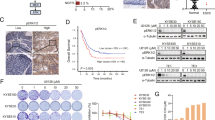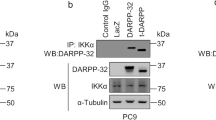Abstract
Overexpression of epidermal growth factor receptor (EGFR) and establishment of transforming growth factor α (TGF α)/EGF autocrine system are frequently detected in tumor cells. In addition to mitogenic ability, we demonstrate in this report that EGF protects a human esophageal carcinoma (CE) cell line, CE81T/VGH, from staurosporine-induced apoptosis. The anti-apoptotic signal of EGF is alleviated by a MEK inhibitor PK98059 or an ERK2 dominant negative mutant but not by a phosphatidylinositol-3′-kinase (PI-3K) inhibitor wortmannin. Furthermore, v-raf blocks apoptosis induced by staurosporine. This evidence implies that the survival signal of EGF is mediated via the Raf-MEK-ERK pathway but not the PI3-K pathway. The survival effect of EGF is coincident with the induction of mcl-1, an anti-apoptotic gene in the bcl-2 family. PD98059 also suppresses the induction of Mcl-1 by EGF, implying that EGF may up-regulate Mcl-1 via the MAP kinase pathway. Overexpression of mcl-1 is sufficient to protect against apoptosis, while transfection of a mcl-1 antisense plasmid causes cell death. The expression of mcl-1 antisense plasmid also suppresses the anti-apoptotic effect of EGF. Taken together, these results indicate that EGF may up-regulate Mcl-1 through the MAP kinase pathway to suppress apoptosis.
This is a preview of subscription content, access via your institution
Access options
Subscribe to this journal
Receive 50 print issues and online access
$259.00 per year
only $5.18 per issue
Buy this article
- Purchase on Springer Link
- Instant access to full article PDF
Prices may be subject to local taxes which are calculated during checkout







Similar content being viewed by others
References
Adams JM and Cory S . 1998 Science 281: 1322–1325
Alessi DR, Cuenda A, Cohen P, Dudley DT and Saltiel AR . 1995 J Biol Chem 270: 27489–27494
Altmeyer A, Simmons RC, Krajewski S, Reed JC, Bornkamm GW and Chen-Kiang S . 1997 Immunity 7: 667–677
Antonsson B, Conti F, Ciavatta A, Montessuit S, Lewis S, Martinou I, Bernasconi L, Bernard A, Mermod J-J, Mazzei G, Maundrell K, Grambale F, Sadoul R and Martinou J-C . 1997 Science 277: 370–372
Basolo F, Serra C, Ciardiello F, Fiore L, Russo J, Campani D, Dolei A, Squartini F and Toniolo A . 1992 Int J Cancer 51: 634–640
Cardone MH, Roy N, Stennicke HR, Salvesen GS, Franke TF, Stanbridge E, Frisch S and Reed JC . 1998 Science 282: 1318–1321
Chao JR, Wang JM, Lee SF, Peng HW, Lin YH, Chou CH, Li JC, Huang HM, Chou CK, Kuo ML, Yen JJ-Y and Yang-Yen HF . 1998 Mol Cell Biol 18: 4883–4898
Chen SC, Chou CK, Wong FH, Chang C and Hu C . 1991 Cancer Res 51: 1898–1903
Collette Y, Razanajaona D, Ghiotto M and Olive D . 1997 Eur J Immunol 27: 3283–3289
Datta SR, Dudek H, Tao X, Masters S, Fu H, Gotoh Y and Greenberg M . 1997 Cell 91: 231–241
del Peso L, Gonzalez-Garcia M, Page C, Herrera R and Nunez G . 1997 Science 278: 687–689
Dragovich T, Rudin CR and Thompson CB . 1998 Oncogene 17: 3207–3213
Dudek H, Datta SR, Franke TF, Birnbaum MJ, Yao R, Cooper GM, Segal RA, Kaplan DR and Greenberg ME . 1997 Science 275: 661–665
Dunn SE, Hardman RA, Kari FW and Barrett JC . 1997 Cancer Res 57: 2687–2693
Fabregat I, Sanchez A, Alvarez AM, Nakamura T and Benito M . 1996 FEBS Lett 384: 14–18
Fitzpatrick SL, LaChance MP and Schultz GS . 1984 Cancer Res 44: 3442–3447
Frost JA, Geppert TD, Cobb MH and Feramisco JR . 1994 Proc Natl Acad Sci USA 91: 3844–3848
Geier A, Weiss C, Berry R, Haimsohn M, Hemi R, Malik Z and Karasik A . 1995 J Cell Physiol 163: 570–576
Hu C, Hsieh HG, Chien KY, Wang PY, Wang CI, Chen CY, Lo SJ, Wuu KD and Chang C . 1984 JNCI 72: 577–583
Iihara K, Shiozaki H, Tahara H, Kobayashi K, Inoue M, Tamura S, Miyata M, Oka H, Doki Y and Mori T . 1993 Cancer 71: 2902–2909
Kozopas KM, Yang T, Buchan HL, Zhou P and Criag RW . 1993 Proc Natl Acad Sci USA 90: 3516–3520
Kulik G, Klippel A and Weber MJ . 1997 Mol Cell Biol 17: 1595–1606
Kulik G and Weber MJ . 1998 Mol Cell Biol 18: 6711–6718
Liu YC, Chen SC, Chang C, Leu CM and Hu C . 1996 Exp Cell Res 228: 206–211
Lu SH, Hsieh LL, Luo FC and Weinstein IB . 1988 Int J Cancer 42: 502–505
Merlo GR, Basolo F, Fiore L, Duboc L and Hynes NE . 1995 J Cell Biol 128: 1185–1196
Minn AJ, Velez P, Schendel SL, Liang H, Muchmore SW, Fesik SW, Fill M and Thompson CB . 1997 Nature 385: 353–357
Minshall C, Arkins S, Freund GG and Kelley KW . 1996 J Immunol 156: 939–947
Omura S, Sasaki Y, Iwai Y and Takeshima H . 1995 J Antibiot 48: 535–548
Osterop APRM, Medema RH, Ouwens DM, Van der Zon GCM, Moller W and Maassen JA . 1994 Biochemistry 33: 7453–7459
Ozawa S, Ueda M, Ando N, Abe O and Shimizu N . 1987 Int J Cancer 39: 333–337
Ozawa S, Ueda M, Ando N, Shimizu N and Abe O . 1989 Cancer 63: 2169–2173
Pang L, Sawada T, Decker SJ and Saltiel AR . 1995 J Biol Chem 270: 13585–13588
Parrizas M, Saltiel AR and LeRoith D . 1997 J Biol Chem 272: 154–161
Pierce JH, Ruggiero M, Fleming TP, Di Fiore PP, Greenberger JS, Varticovski L, Schlessinger J, Rovera G and Aaronson SA . 1988 Science 239: 628–631
Rapp UR, Goldsborough MD, Mark GE, Bonner TI, Groffen J, Reynolds Jr FH and Stephenson JR . 1983 Proc Natl Acad Sci USA 80: 4218–4222
Reynolds JE, Li J, Craig RW and Eastman A . 1996 Exp Cell Res 225: 430–436
Reynolds JE, Yang T, Qian L, Jenkinson JD, Zhou P, Eastman A and Craig RW . 1994 Cancer Res 54: 6348–6352
Ruegg UT and Burgess GM . 1989 Trends Pharmacol Sci 10: 218–220
Sato N, Sakamaki K, Terada N, Arai KI and Miyajima M . 1993 EMBO J 12: 4181–4189
Sato T, Hanada M, Bodrug S, Irie S, Iwama N, Boise LH, Thompson CB, Golemis E, Fong L, Wang HG and Reed JC . 1994 Proc Natl Acad Sci USA 91: 9238–9242
Schendel SL, Xie Z, Montal MO, Matsuyama S, Montal M and Reed JC . 1997 Proc Natl Acad Sci USA 94: 5113–5118
Shao RG, Shimizu T and Pommier Y . 1997a Exp Cell Res 234: 388–397
Shao RG, Cao CX, Shimizu T, O'Connor PM, Kohn KW and Pommier Y . 1997b Cancer Res 57: 4029–4035
Singleton JR, Dixit VM and Feldman EL . 1996 J Biol Chem 271: 31791–31794
Thornberry NA and Lazebnik Y . 1998 Science 281: 1312–1316
Townsend KJ, Trusty JL, Traupman MA, Eastman A and Craig RA . 1998 Oncogene 17: 1223–1234
Turner BC, Haffty BG, Narayanan L, Yuan J, Havre PA, Gumbs AA, Kaplan L, Burgaud JL, Carter D, Baserga R and Glazer PM . 1997 Cancer Res 57: 3079–3083
Wang JM, Chao JR, Chen W, Kuo ML, Yen JJ-Y and Yang-Yen HF . 1999 Mol Cell Biol 19: 6195–6206
Wang Q, Worlan PJ, Clark JL, Carson BA and Sausville EA . 1995 Cell Growth Diff 6: 927–936
Wong FH, Hu C, Chen SC, Yu YT and Chang C . 1992 Chinese J Microbiol Immunol 25: 59–68
Xia Z, Dickens M, Raingeaud J, Davis RJ and Greenberg ME . 1995 Science 270: 1326–1331
Yang E and Korsmeyer SJ . 1996 Blood 88: 386–401
Yang T, Kozopas KM and Craig RW . 1995 J Cell Biol 128: 1173–1184
Yao R and Cooper GM . 1995 Science 267: 2003–2006
Zamorano J, Wang HY, Wang LM, Pierce JH and Keegan AD . 1996 J Immunol 157: 4926–4934
Zha J, Harada H, Yang E, Jockel J and Korsmeyer SJ . 1996 Cell 87: 619–628
Acknowledgements
We thank Dr Hsin-Fang Yang-Yen, Institute of Molecular Biology, Academia Sinica, Taipei, Taiwan, Dr Hsian-Fu Kung, NCI-Frederick Cancer Research and Development Center, Frederick, and Dr Melanie H Cobb, University of Texas, Southwestern Medical Center, Dallas, for their generously provided plasmids. We appreciate Dr Chi-Hung Lin, Institute of Microbiology and Immunology, National Yang-Ming University, Taipei, Taiwan, for his excellent technical advice in the photography of double staining. We thank Ms Wen-Hsuang Fong for her assistance in the construction of mcl-1 antisense plasmid. We also thank Dr Chen-Kung Chou, Department of Medical Research and Education, Veterans General Hospital, Taipei, Taiwan and Dr Ming-Zong Lai, Institute of Molecular Biology, Academia Sinica, Taipei, Taiwan, for their inspirational suggestions. We thank Dr Jeou-Yuan Chen for her critical review and suggestions in the preparation of the manuscript and Ms Shiang-Lien Lu for her excellent secretarial assistance. This work was supported by the National Science Council, grants NSC86-2314-B-075-031, NSC87-2314-B-075-061, and NSC88-2314-B-075-013.
Author information
Authors and Affiliations
Rights and permissions
About this article
Cite this article
Leu, CM., Chang, C. & Hu, Cp. Epidermal growth factor (EGF) suppresses staurosporine-induced apoptosis by inducing mcl-1 via the mitogen-activated protein kinase pathway. Oncogene 19, 1665–1675 (2000). https://doi.org/10.1038/sj.onc.1203452
Received:
Revised:
Accepted:
Published:
Issue Date:
DOI: https://doi.org/10.1038/sj.onc.1203452
Keywords
This article is cited by
-
Protease-activated receptor 2 attenuates doxorubicin-induced apoptosis in colon cancer cells
Journal of Cell Communication and Signaling (2023)
-
Targeting MCL-1 sensitizes human esophageal squamous cell carcinoma cells to cisplatin-induced apoptosis
BMC Cancer (2017)
-
EGF-mediated induction of Mcl-1 at the switch to lactation is essential for alveolar cell survival
Nature Cell Biology (2015)
-
Chlamydia inhibit host cell apoptosis by inducing Bag-1 via the MAPK/ERK survival pathway
Apoptosis (2013)
-
Ovarian cancer ascites increase Mcl-1 expression in tumor cells through ERK1/2-Elk-1 signaling to attenuate TRAIL-induced apoptosis
Molecular Cancer (2012)



